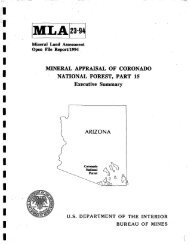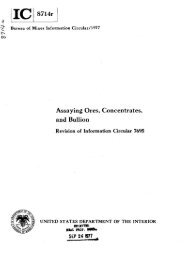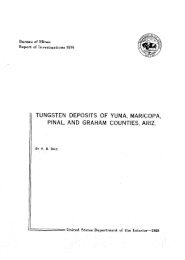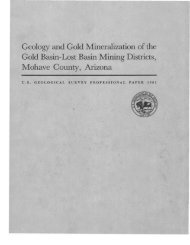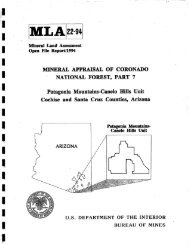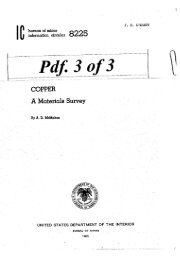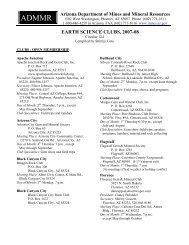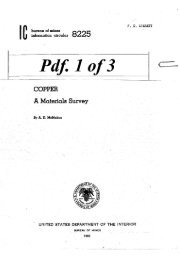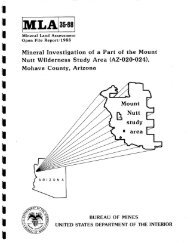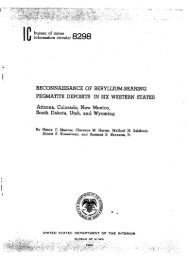here - State of Arizona Department of Mines and Mineral Resources
here - State of Arizona Department of Mines and Mineral Resources
here - State of Arizona Department of Mines and Mineral Resources
Create successful ePaper yourself
Turn your PDF publications into a flip-book with our unique Google optimized e-Paper software.
COVE DISTRICT<br />
The Cove district is 45 miles northeast <strong>of</strong> Bakersfield<br />
near Kernville, in T. 25 S., R. 33 E.<br />
In the late 1850's a few placers were worked in<br />
the Cove district by the more persistent <strong>of</strong> the<br />
prospectors drawn to the area by the original discoveries<br />
in Kern County, along the Kern River, in<br />
1851. Gold-bearing quartz veins were found in 1860.<br />
The towns <strong>of</strong> Quartzburg <strong>and</strong> Kernville, which were<br />
founded in the boom that followed, experienced a<br />
period <strong>of</strong> orderly growth <strong>and</strong> prosperity. The Big<br />
Blue mine <strong>of</strong> Kern <strong>Mines</strong>, Inc., was discovered early<br />
in the history <strong>of</strong> the district. The mine became the<br />
major producer <strong>and</strong> was credited with $1,746,910<br />
in gold to 1933 (Tucker <strong>and</strong> others, 1949, p. 211) ;<br />
most <strong>of</strong> this production was in the first few years<br />
<strong>of</strong> the mine's activity. In 1883 most <strong>of</strong> the workings<br />
were destroyed by fire, <strong>and</strong> the mine was inactive<br />
until 1907 when the first <strong>of</strong> several unsuccessful<br />
attempts was made to rehabilitate the property.<br />
Total gold production <strong>of</strong> the district through 1959<br />
was about 262,800 ounces; none had been reported<br />
since 1942.<br />
The country rock consists <strong>of</strong> metasedimentsphyllites,<br />
quartzites, <strong>and</strong> limestone <strong>of</strong> the Kernville<br />
Series <strong>of</strong> Carboniferous (1) age, <strong>and</strong> the Isabella<br />
Granodiorite <strong>and</strong> acidic dikes <strong>of</strong> Jurassic(?) age.<br />
The granodiorite is probably related to the main<br />
Sierra Nevada batholith (Prout, 1940, p. 385-389;<br />
Miller <strong>and</strong> Webb, 1940, p. 378).<br />
The metamorphic rocks are intensely deformed<br />
<strong>and</strong> crumpled by the intrusive rock. Along the east<br />
edge <strong>of</strong> the Cove district is the north-trending Kern<br />
Canyon fault, the major structure in the area.<br />
Ore deposits consist <strong>of</strong> veins which seem to be<br />
related to the closing stages <strong>of</strong> igneous activity. The<br />
veins occur in shear zones, parallel to the Kern<br />
Canyon fault, <strong>and</strong> are associated with acidic dikes<br />
that cut the granodiorite <strong>and</strong> metasediments (Prout,<br />
1940, p. 386, 391-392). The veins are dominantly<br />
quartz with small amounts <strong>of</strong> calcite. The ore minerals<br />
are gold, which occurs in the free state, arsenopyrite,<br />
galena, <strong>and</strong> sphalerite (Prout, 1940,<br />
p. 411-412).<br />
GREEN MOUNTAIN DISTRICT<br />
The Green Mountain district includes the area<br />
between Piute, on the west slope <strong>of</strong> the Piute Mountains,<br />
<strong>and</strong> the edge <strong>of</strong> Kelsey Valley, on the east side<br />
<strong>of</strong> the Piute Mountains.<br />
Gold production <strong>of</strong> this district through 1959 was<br />
about 33,100 ounces. The Bright Star mine was the<br />
major producer, with an estimated $600,000 total<br />
output (Tucker <strong>and</strong> Sampson, 1933, p. 280).<br />
CALIFORNIA 65<br />
Bedrock in the area consists <strong>of</strong> metasedimentary<br />
rocks <strong>of</strong> the Kernville Series <strong>of</strong> Carboniferous (1)<br />
age <strong>and</strong> Isabella Granodiorite <strong>of</strong> Jurassic (1) age<br />
(Miller <strong>and</strong> Webb, 1940, p. 349-358). The metasedimentary<br />
rocks occur in northwest-trending b<strong>and</strong>s<br />
<strong>and</strong> include marble, phyllite, mica schist, <strong>and</strong><br />
quartzite. The gold deposits are in small, but rich,<br />
shoots in narrow quartz veins.<br />
KEYES DISTRIOV<br />
The Keyes district, 35 miles north <strong>of</strong> Calientp. in<br />
T. 26 S., Rs. 32 <strong>and</strong> 33 E., produced about 3S,600<br />
ounces <strong>of</strong> gold through 1959, all from lodes.<br />
Detailed accounts <strong>of</strong> the history <strong>and</strong> geolog:'T <strong>of</strong><br />
this district were not found; however, Tucker <strong>and</strong><br />
Sampson (1933, p. 283) reported that the deposits<br />
in the district are in narrow high-grade vein" in<br />
granite.<br />
RAND DISTRICT<br />
The R<strong>and</strong> district is on the San Bernardino-Yern<br />
County line. R<strong>and</strong>sburg, 45 miles northeast <strong>of</strong><br />
Mojave, is in the center <strong>of</strong> the district. Althc'lgh<br />
more than half the area is in San Bernardino<br />
County, nearly all the gold mined in the district<br />
has come from the western part, in Kern County.<br />
This is the most important district in Kern County,<br />
<strong>and</strong> it contains the largest gold mine in the county,<br />
the Yellow Aster. Gold has been the chief r'lmmodity<br />
mined; silver has been a byproduct.<br />
Placer gold was discovered in the winter <strong>of</strong> U'q3<br />
94 at Goler Wash, 9 miles northwest <strong>of</strong> R<strong>and</strong>sb'lrg,<br />
<strong>and</strong> by 1895 the lode deposits <strong>of</strong> the Yellow Aster<br />
mine were developed (Hess, 1910, p. 31-32). Of the<br />
estimated $9 to $10 million worth <strong>of</strong> ore mined<br />
before 1910, the Yellow Aster produced $6 miJIion<br />
(Hess, 1910, p. 32).<br />
Tucker <strong>and</strong> Sampson (1933, p. 285-286) ("ave<br />
estimates <strong>of</strong> the production <strong>and</strong> a brief account <strong>of</strong><br />
the geology. Gold production through 1959 was<br />
836,300 ounces, all but about 1,700 ounces was<br />
from lode mines.<br />
The country rock in the gold-producing par <strong>of</strong><br />
the district consists <strong>of</strong> the R<strong>and</strong> Schist <strong>and</strong> the<br />
Atolia Quartz Monzonite which intruded the scl'ist.<br />
Numerous rhyolite pipes, dikes, <strong>and</strong> sills <strong>of</strong> late<br />
Miocene age are found locally. Gold ores occur in<br />
fissure veins <strong>and</strong> as impregnations <strong>and</strong> stockworks<br />
in both the monzonite <strong>and</strong> R<strong>and</strong> schist. The<br />
strongest veins have been found to be in two systems-one<br />
strikes N. 80° E. <strong>and</strong> the other, northwest.<br />
The principal vein minerals are quartz, arsenopyrite,<br />
pyrite, galena, gold, scheelite, iron



